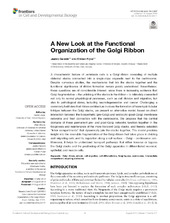| dc.contributor.author | Saraste, Jaakko | en_US |
| dc.contributor.author | Prydz, Kristian | en_US |
| dc.date.accessioned | 2020-04-17T10:04:18Z | |
| dc.date.available | 2020-04-17T10:04:18Z | |
| dc.date.issued | 2019-08-21 | |
| dc.Published | Saraste J, Prydz K. A New Look at the Functional Organization of the Golgi Ribbon. Frontiers in Cell and Developmental Biology. 2019;7:171 | eng |
| dc.identifier.issn | 2296-634X | |
| dc.identifier.uri | https://hdl.handle.net/1956/21910 | |
| dc.description.abstract | A characteristic feature of vertebrate cells is a Golgi ribbon consisting of multiple cisternal stacks connected into a single-copy organelle next to the centrosome. Despite numerous studies, the mechanisms that link the stacks together and the functional significance of ribbon formation remain poorly understood. Nevertheless, these questions are of considerable interest, since there is increasing evidence that Golgi fragmentation – the unlinking of the stacks in the ribbon – is intimately connected not only to normal physiological processes, such as cell division and migration, but also to pathological states, including neurodegeneration and cancer. Challenging a commonly held view that ribbon architecture involves the formation of homotypic tubular bridges between the Golgi stacks, we present an alternative model, based on direct interaction between the biosynthetic (pre-Golgi) and endocytic (post-Golgi) membrane networks and their connection with the centrosome. We propose that the central domains of these permanent pre- and post-Golgi networks function together in the biogenesis and maintenance of the more transient Golgi stacks, and thereby establish “linker compartments” that dynamically join the stacks together. This model provides insight into the reversible fragmentation of the Golgi ribbon that takes place in dividing and migrating cells and its regulation along a cell surface – Golgi – centrosome axis. Moreover, it helps to understand transport pathways that either traverse or bypass the Golgi stacks and the positioning of the Golgi apparatus in differentiated neuronal, epithelial, and muscle cells. | en_US |
| dc.language.iso | eng | eng |
| dc.publisher | Frontiers | eng |
| dc.rights | Attribution CC BY | eng |
| dc.rights.uri | http://creativecommons.org/licenses/by/4.0/ | eng |
| dc.subject | Golgi ribbon | eng |
| dc.subject | mitosis | eng |
| dc.subject | cell migration | eng |
| dc.subject | cell differentiation | eng |
| dc.subject | Golgi bypass | eng |
| dc.subject | centrosome | eng |
| dc.subject | intermediate compartment | eng |
| dc.subject | recycling endosome | eng |
| dc.title | A New Look at the Functional Organization of the Golgi Ribbon | en_US |
| dc.type | Peer reviewed | |
| dc.type | Journal article | |
| dc.date.updated | 2019-11-15T15:40:13Z | |
| dc.description.version | publishedVersion | en_US |
| dc.rights.holder | Copyright 2019 Saraste and Prydz | |
| dc.identifier.doi | https://doi.org/10.3389/fcell.2019.00171 | |
| dc.identifier.cristin | 1739653 | |
| dc.source.journal | Frontiers in Cell and Developmental Biology | |

